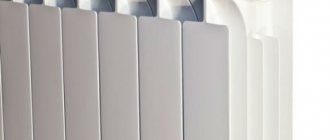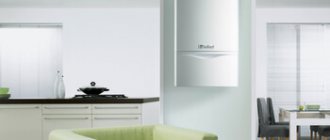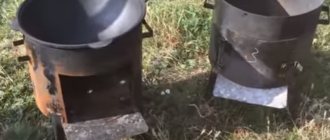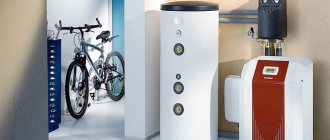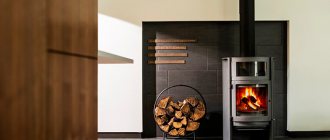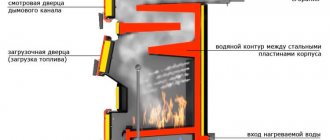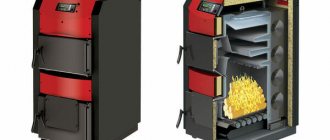Distinctive features
The operation of any of the systems based on long-term combustion of fuel occurs by ensuring the combustion of pyrolysis gases . They are released when organic fuel burns slowly.
Air ducts in such structures have their own characteristics, due to which the wood smolders and releases hydrocarbons in the form of gas.
The operating principle of fireplace stoves is as follows:
- Pyrolysis gases, which are formed during the slow oxidation of organic-based fuel, come into contact with air and then enter the combustion chamber. As a result of the process, a significant amount of thermal energy is released.
- The resulting heat can be used to transfer temperature to a coolant or a boiler with an indirect type of heating.
IMPORTANT!
An important advantage of a fireplace stove is the minimal level of soot formation during combustion of pyrolysis compounds. But it is worth considering that when installing such a device, you need to properly install the chimney . It will allow for high-quality removal of waste gases, ensuring the safety of residents and the efficiency of the furnace.
Carrying out installation work
A cast iron fireplace stove with a hob, just like the simplest models, has a similar and fairly simple installation that does not require certain knowledge, skills, professional and expensive equipment and tools.
Installation and installation instructions:
- Installation and selection of location, room, is carried out according to the location of the chimney itself, if it is already installed in the house;
- The chimney pipe is vertical. This element can be made of oven refractory bricks or assembled from sandwich pipes made of stainless steel;
- A cast iron insert in the fireplace can be included in the initial kit or purchased separately;
- Regardless of the quality and materials of the floor covering, before installing the fireplace on it, a small podium or pedestal is laid out from any heat-resistant coating;
The power of the unit is selected based on the size and number of floors of the house
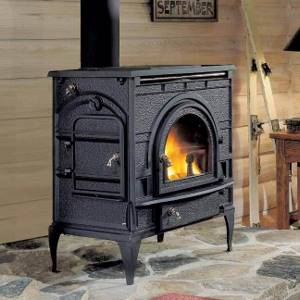
If there are special fastenings, the model must be fixed to give it additional stability.
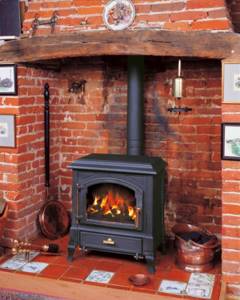
Installation is carried out on a previously prepared surface
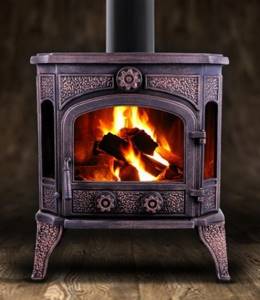
The length of the chimney should not be less than five meters
- When equipping a fireplace with a portal, the materials used for making the frame and used for cladding must also be characterized by high strength, environmental friendliness and fire resistance. At the same time, the style of the product must be in harmony and intersect with the interior of the room chosen for installation;
- The chimney pipe is fixed at your choice in the back or top of the hearth;
- If there are fixing elements, the installation is given stability by securing them in the required manner.
Interesting to know: if you want to assemble such a fireplace at home, you will definitely need to master cast iron casting for fireplaces. This will open up wider possibilities for you and will subsequently allow you to make even the smallest parts, elements and decor from this material with your own hands.
You can learn more about the process of installing and selecting such a stove by watching the video in this article.
Rating of TOP 10 best models
| Place | Name | Price |
| TOP 5 best long-burning cast iron fireplace stoves | ||
| 1 | La Nordica Ghisa Isotta Con Cerchi | Find out the price |
| 2 | META Marseille 14 | Find out the price |
| 3 | META Moscow 12 | Find out the price |
| 4 | MBS Thermo Vesta plus | Find out the price |
| 5 | Flamen TENA | Find out the price |
| TOP 5 best long-burning fireplace stoves | ||
| 1 | META Rhine | Find out the price |
| 2 | Brandenburg with cast iron stove | Find out the price |
| 3 | Invicta Chamane | Find out the price |
| 4 | Teplodar Vertical ceramics | Find out the price |
| 5 | THORMA Milano II | Find out the price |
Constructive decisions
Fireplace stoves are made, in most cases, from steel and cast iron.
Steel - have impressive weight and thick walls. They heat up quickly and cool down just as quickly, designed for small spaces - dachas, country houses.
Cast iron - not much larger in weight, but they take longer to warm up, can heat large rooms, and are more expensive. Cast iron stoves and fireplaces are chosen mainly for home use.
Facing - ceramics, stone, less often - brick. They will quickly heat the room. A sufficiently large viewing glass will allow you to admire the play of fire.
Doors can be straight, semicircular or three-sided. The opening mechanism can also vary - to the side or up. To ensure that the door glass always remains transparent, fireplace stoves have a clean glass option - an air flow is supplied to the glass from the inside, forming an air cushion that prevents soot from settling on the glass. Firewood is also inserted into the combustion chamber through the door. The efficiency of closed fireplace stoves is quite high - 80-90%.
You can control the combustion process and wood consumption yourself by increasing or decreasing the air supply. You can save even more on fuel by using fuel briquettes - compressed sawdust, which are much more efficient in their fuel qualities.
Some models have a built-in heat exchanger in their design. With its help, you can heat adjacent rooms by installing radiators, even if there is a blank partition. It is especially worth noting designs with a water circuit - this is a good solution for permanent residences.
Beauty, comfort, warm home. What else can stoves and fireplaces give you? Delicious dinner. Like a traditional Russian oven, you can cook and heat food in them and even cook shish kebab over an open fire. It’s up to you, of course, to choose a stove or a fireplace, or two in one.
Fireplace power
To choose the ideal unit for your garden or home, you first need to decide on the power. It will not be difficult to calculate this: based on calculations of 1 kW of energy per 10 sq.m. with a ceiling height of 2.5-2.7 meters.
For example, if the house area is 350 sq.m., you will need a fireplace stove producing 35 kW. It is also worth taking into account the number of window and door openings, rooms - heat in the room constantly circulates as it heats up and cools down. Do not forget about the climatic characteristics of the region in which the building is located. Based on all these parameters, we calculate with a reserve and add another 15-30% to the estimated power (depending on the listed factors).
The most popular wood-burning fireplace stoves are models that have a secondary combustion system, which will dramatically reduce wood consumption. Ceramic cladding allows you to warm up the room even after the fire has died down. Glass also gives off heat. Dark cladding is less of a mark. The manufacturer has a line of stoves made of cast iron.
If all the calculations have been made and you have decided on the type of heating device, let’s consider the most popular models in this segment.
VIDEO: Operating principle and difference from the Russian stove
Pay attention to the material that is used as the lining.
Lining - a layer of insulating material inside the metal furnace firebox
Fireclay brick is the most popular lining material, but is considered obsolete to a certain extent. It is quite heavy, porous and short-lived.
Vermiculite is a modern material: fireproof, hard, dense, with high wear resistance and resistance to chemical attack from combustion products.
Cast fireclay is a composite material with increased strength and fire resistance: white, smooth, non-porous.
Currently, a number of manufacturers of fireplace stoves are already using their materials for lining: Acumotte, Termotec, Reallit, etc. They are based on cast fireclay, to which various substances are simply added that increase strength, self-cleaning, durability and other quality parameters of the lining.
Fig. 2. Fireplace furnace lined with fireclay bricks
